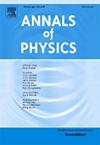The effect of a new position-dependent effective mass on the optical properties of a hydrogenic donor in a spherical quantum dot
IF 3
3区 物理与天体物理
Q2 PHYSICS, MULTIDISCIPLINARY
引用次数: 0
Abstract
The influence of a new position-dependent effective mass on the electronic and optical properties of a hydrogenic donor in a GaAs quantum dot is investigated. The electron mass is modeled as a function of spatial position, temperature, and hydrostatic pressure, allowing for a more comprehensive understanding of the system’s behavior under varying external conditions. The position-dependent radial Schrödinger equation is solved for the spherical Coulomb potential, and the bound state energy eigenvalues, along with the corresponding wave functions, are computed using the Runge–Kutta method. The effects of position-dependent effective mass and donor radius on confinement energy, dipole matrix element, absorption coefficient, and refractive index change are analyzed. This study underscores the importance of incorporating position-dependent mass, temperature, and hydrostatic pressure in calculating the electronic and optical properties of the hydrogenic donor in the GaAs quantum dot.
新的位置相关有效质量对球形量子点中氢给体光学性质的影响
研究了GaAs量子点中新的位置相关有效质量对氢给体电子和光学性质的影响。电子质量被建模为空间位置、温度和静水压力的函数,从而可以更全面地理解系统在不同外部条件下的行为。求解了球面库仑势的位置依赖径向Schrödinger方程,并利用龙格-库塔法计算了束缚态能量特征值以及相应的波函数。分析了位置相关的有效质量和给体半径对约束能、偶极矩阵元素、吸收系数和折射率变化的影响。本研究强调了在计算GaAs量子点中氢供体的电子和光学性质时,结合位置相关质量、温度和静水压力的重要性。
本文章由计算机程序翻译,如有差异,请以英文原文为准。
求助全文
约1分钟内获得全文
求助全文
来源期刊

Annals of Physics
物理-物理:综合
CiteScore
5.30
自引率
3.30%
发文量
211
审稿时长
47 days
期刊介绍:
Annals of Physics presents original work in all areas of basic theoretic physics research. Ideas are developed and fully explored, and thorough treatment is given to first principles and ultimate applications. Annals of Physics emphasizes clarity and intelligibility in the articles it publishes, thus making them as accessible as possible. Readers familiar with recent developments in the field are provided with sufficient detail and background to follow the arguments and understand their significance.
The Editors of the journal cover all fields of theoretical physics. Articles published in the journal are typically longer than 20 pages.
 求助内容:
求助内容: 应助结果提醒方式:
应助结果提醒方式:


